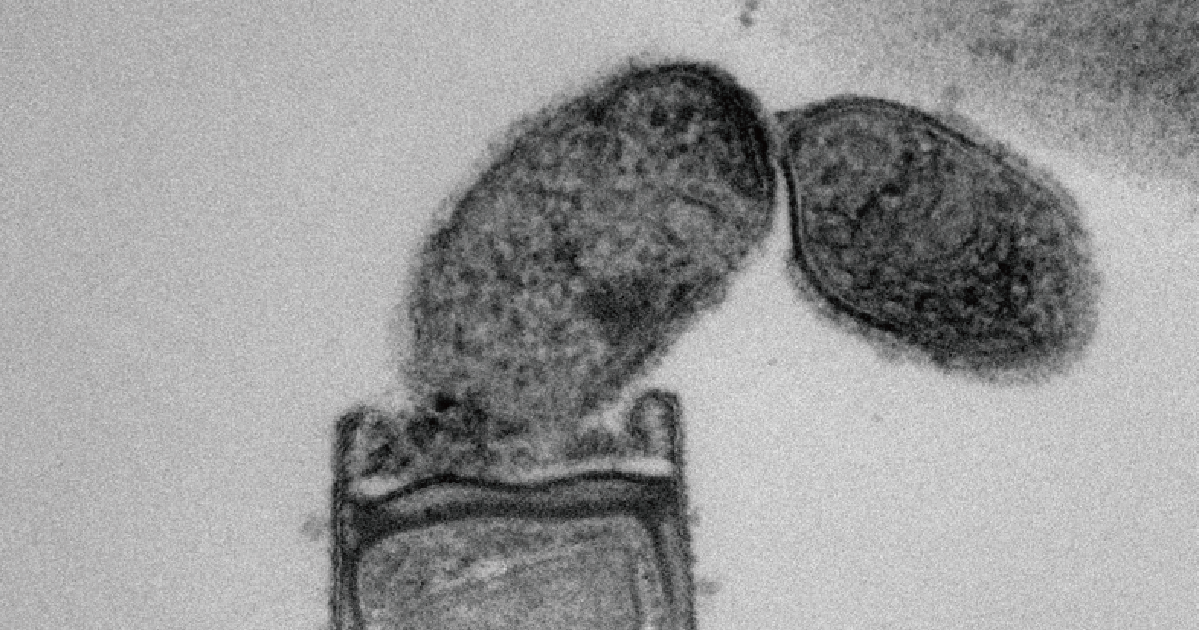Feb. 12, 2025
Novel methanogenic archaea-parasitizing bacteria
Successful isolation of ultrasmall bacteria belonging to the CPR, a large phylogenetic group that include various lineages of uncultivated bacteria
- Research
Points
- Achieved the first successful isolation of ultrasmall bacteria parasitic to methanogenic archaea in the world
- Observed a unique parasitic interaction between the isolate and its host methanogenic archaea
- We proposed Minisyncoccus archaeiphilus PMX.108T gen. nov., sp.nov. and the associated family, order, class, and phylum as Minisyncoccaceae fam. nov. Minisyncoccales nov., Minisyncoccia class. nov. and Minisyncoccota phyl. nov., respectively.

The first successful two-strain co-culture of the ultrasmall CPR bacteria Minisyncoccus archaeiphilus strain PMX.108T (=JCM 39522T) in the world.
* Figures from the original paper have been cited and modified.
Summary
AIST researchers, in collaboration with JAMSTEC, Hokkaido University and Tohoku University,
have succeeded in cultivating an ultrasmall bacterial strain parasitizing methanogenic archaea and classified the strain PMX.108T as new species and genus of Minisyncoccus archaeiphilus.
We have discovered, for the first time in the world, bacteria that parasitize the methanogenic archaea, which play a central role in anaerobic wastewater treatment systems.
The ultrasmall bacterium inhibits the growth of the host methanogenic archaeon Methanospirillum hungatei.
This study represents the first successful cultivation of ultrasmall bacteria that parasitize Archaea,
which evolutionarily diverged approximately 4 billion years ago and exhibit significant biological differences in cell membrane lipids, genetic information, and other biochemical characteristics.
The bacterium was observed to have limited host range and to attach only host archaeon-specific sites.
Furthermore, we have proposed a new phylum Minisyncoccota formerly known as "Candidate phyla radiation (CPR)”.
The phylogenetically classification and deposition of the CPR bacterium to a public culture collections will advance research on the CPR bacteria,
and is expected to advance our understanding of the physiology and ecological role of the bacteria, which have remained a mystery until now.
Background
Candidate phyla radiation, a large bacterial phylogenetic group that includes various uncultivated lineages, are ubiquitous in natural and artificial environments, but their ecophysiology in ecosystems remains largely unknown due to the difficulty of cultivating them. The CPR bacteria have been predicted to adopt a parasitic or predatory lifestyles on the host organisms because of their small cell and genome size and lack of biosynthetic pathways for their growth. Although some CPR bacteria that demonstrate intra-domain interactions have been successfully cultured, there are no cases where cultured strains have been made publicly available through culture collections, which is hindering the progress in the research field.
Paper Information
- Journal
- International Journal of Systematic and Evolutionary Microbiology
- Title of paper
- Minisyncoccus archaeiphilus gen. nov., sp. nov., a mesophilic, obligate parasitic bacterium, and proposal of Minisyncoccaceae fam. nov., Minisyncoccales ord. nov., Minisyncoccia class. nov., and Minisyncoccota phyl. nov. formerly referred to as Candidatus Patescibacteria or Candidate Phyla Radiation
- Authors
- Meri Nakajima, Ryosuke Nakai, Yuga Hirakata, Kengo Kubota, Hisashi Satoh, *Masaru K. Nobu, *Takashi Narihiro, and *Kyohei Kuroda [* indicates corresponding authors]
Researchers
Kyohei Kuroda, Senior Researcher
Takashi Narihiro, Group Leader
Ryosuke Nakai, Senior Researcher
Takashi Narihiro, Group Leader
Ryosuke Nakai, Senior Researcher
Microbial Ecology and Technology Research Group, Department of Life Science and Biotechnology, Bioproduction Research Institute, National Institute of Advanced Industrial Science and Technology (AIST)
Yuga Hirakata, AIST Postdoctoral Researcher
Microbial and Genetic Resources Research Group, Department of Life Science and Biotechnology, Bioproduction Research Institute, National Institute of Advanced Industrial Science and Technology (AIST)
Meri Nakajima, doctoral student
Hokkaido University, Graduate School of Engineering
Hisashi Satoh, Professor
Hokkaido University, Faculty of Engineering
Kengo Kubota Associate Professor
Tohoku University, Graduate School of Environmental Studies
Masaru K. Nobu, Senior researcher
Japan Agency for Marine-Earth Science and Technology (JAMSTEC), Institute for Extra-cutting-edge Science and Technology Avant-garde Research (X-star)



